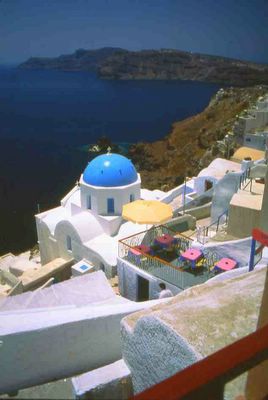
(To blog readers: My son is traveling to Greece in April with a group from Massachusetts’ Oliver Ames [OA] High School [see March 5 post]. To give students and parents a glimpse of some of the places on the group’s itinerary and to provide links to sites the travelers may find helpful, I’m devoting 10 consecutive daily posts from March 22 through March 31 to places on the kids’ Greek itinerary. [I can’t think of a better place than Greece to hang, really or virtually, but if you’d like to go elsewhere, cruise the archives to visit scores of other great places, from Jamaica to Jordan, Malta to Mexico.] Wherever you end up, Kalo taxidi! Have a good trip.)
A few hours after arriving on Santorini, I made my daily journal entry, part of which reads, “Incomparable. Glorious. The setting by itself makes a trip halfway across the globe, even for an hour, worthwhile.”
The OA kids have more than an hour to spend on Santorini, one of the most beautiful places on earth. Whether called by its ancient name, Thira, for an 8th-century Spartan colonizer, or by the more recent Byzantine name evoking Saint Irene, the island, shaped by an epic volcanic explosion that caused a tidal wave that rolled as far as Crete and perhaps wiped out King Minos and his Minoans, is a place of a lifetime.
The OA kids are taking a ferry to Santorini, and the sea approach is mind-blowing. Santorini may or may not be the volcanic vestige of lost Atlantis, but when your ship carves through the Aegean and puts you face to face with the dramatic cliff-faced island thrust a thousand feet above the sea, white-washed houses and blue-domed churches sprinkled across the rim of the ancient volcano like sparkling cubes of sugar, you’re in a mood to believe any myth or legend.
From the ferry terminal, it’s a 587-step walk or donkey ride up the cobbled, switchback path from the sea to Fira, the island’s main town. There’s also a vertiginous road, plied by taxis and buses.
Fira town, where the OA kids are staying, is tourist central. Travelers from all over the world walk Fira’s streets in shorts and sandals looking for cheap food, lodging and ferry rates to Paros, Naxos, Ios, Crete, Piraeus. Fira’s streets are good for eating, shopping, people watching.
But the view’s the thing, and all eyes inevitably, irresistibly turn outward toward the Aegean and the wondrous physical beauty of a place created by one of the biggest natural blasts in history. Four thousand years ago, Thira was a mountain, a volcano rising from the sea. When the volcano exploded, the mountain collapsed, and its slopes became today’s croissant-shaped island. Santorini is the rim of the exploded volcano, and its spectacular bay – yellow, gold, orange, blue, magenta or wine-dark depending on the position of the sun – is the crater, a seven-mile-wide, sea-filled caldera.
Santorini. Ancient inferno turned paradise.
Comments or questions? Email me.
www.LoriHein.com
